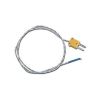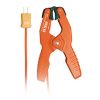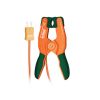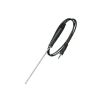Extech 4-Channel Datalogging Thermometer
The Extech 4-Channel Datalogging Thermometer consists of 6 Thermocouple types (J, K, E, T, R,S and 2-channel datalogging with RTD (Pt100Ω) probes.
Features
- User programmable sampling rate: 1 to 3600 seconds
- Built-in PC interface
- Displays [T1, T2, T3, T4] or differential [T1-T2] reading
- Free ground shipping
- Expedited repair and warranty service
- Lifetime technical support
- More
The Extech 4-Channel Datalogging Thermometer displays and stores temperature readings from up to four (4) Type K, J, T, E, R, or S thermocouple temperature probes and two (2) Pt100 RTD probes. The meter stores up to 99 readings manually and 20m readings via the 2G SD card. In addition, an RS232 port allows data streaming to a PC.
- Type J: -148 to 2192 F (-100 to 1200 C)
- Type K: -148 to 2372 F (-100 to 1300 C)
- Type T: -58 to 752 F (-50 to 400 C)
- Type E: -58 to 1652 F (-50 to 900 C)
- Type R: 32 to 3092 F (0 to 1700 C)
- Type S: 32 to 2732 F (0 to 1500 C)
- RTD (Pt100): -327 to 1562 F (-200 to 850 C)
- Resolution: 0.1/1 degree
- Types J,K,E,T,Pt100 Accuracy: +/-0.4% rdg (+1.8 F/+1 C)
- Types R,S Accuracy: +/-0.5% rdg (+2 F/+1 C)
- Datalogging: 20M data records using a 2G SD card
- Dimensions: 7.2x2.9x1.9" (182x73x47.5mm)
- Weight: 17.6oz (500g)
- (1) Datalogging thermometer
- (4) General purpose Type K bead wire temperature probes
- (1) 2GB SD memory card
- (6) AA batteries
- (1) Hard carrying case
In The News
Lake Erie Volunteer Science Network: Building Trust in Citizen Science Programs
Citizen science programs have popped up across the United States, focusing on connecting local communities with nearby water resources and building a trustworthy data pool over the sampling period. While commonly utilized as a means of ensuring that large watersheds or lake regions are adequately sampled, the credibility and success of such programs have been called into question. [caption id="attachment_38996" align="alignnone" width="940"] HRWC volunteers measure stream velocity across a subsection of Woods Creek, a tributary of the Huron River near Belleville, Michigan. Stream velocity measurements can be combined with water level measurements to calculate stream flow and chemical parameter loads.
Read MoreMonitoring Lake Erie’s Eastern Basin: Building Long-Term Data and Real-Time Public Solutions
In the eastern basin of Lake Erie, off the coast of Dunkirk, New York, a data buoy collects valuable water quality, weather, and wave data that inform residents and regulatory groups of conditions on the water. Since 2011, Buffalo State University’s Great Lakes Center has maintained and operated the Dunkirk buoy with funding from the Great Lakes Observing System (GLOS) and field support from the NYSDEC Lake Erie Fisheries Research Unit. [caption id="attachment_38976" align="aligncenter" width="940"] The Dunkirk Buoy viewed from the research vessel after being deployed in early spring.
Read MoreSonTek CastAway-CTD Meter Review
Lightweight and easy to use, the SonTek CastAway offers a convenient 3-in-1 solution for measuring conductivity, temperature, and depth profiles. At a 5 Hz sampling rate, the CastAway is designed for up to 1 m/s free-fall through the water column. With fast response and accurate conductivity, temperature, and depth measurements, the CastAway is ideal for thermocline and halocline profiling. The unit also reports salinity and speed of sound. [caption id="attachment_38732" align="alignnone" width="940"] Environmental scientist, Katelyn Kubasky, holding the SonTek CastAway in front of the pond at the Fondriest Center for Environmental Studies.
Read More
















